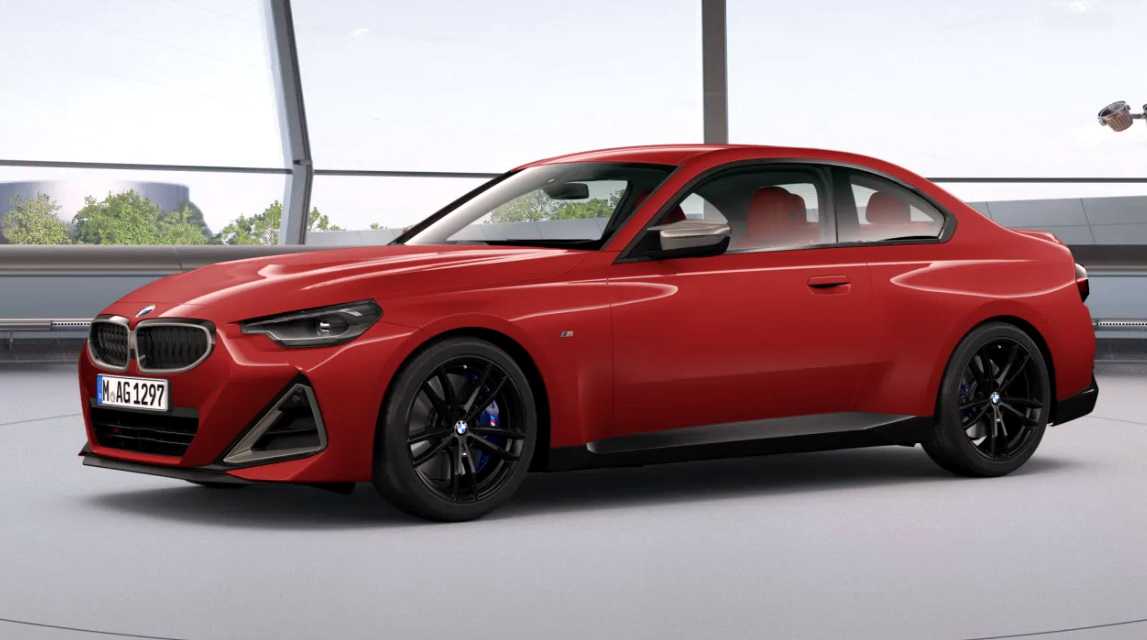BMW 2 SERIES COUPE 2023 Engine compartment And Maintenance

The BMW 2 Series Coupe 2023 is a sports car that boasts a powerful engine and requires regular maintenance to keep it in top condition. The engine compartment is situated at the front of the vehicle and is easily accessible for routine maintenance. The 2.0-liter BMW TwinPower Turbo inline 4-cylinder engine generates up to 255 horsepower and 295 lb-ft of torque and is coupled with an 8-speed Sport Automatic transmission, which delivers smooth and efficient shifting. To maintain the engine of the 2 Series Coupe 2023, it is vital to adhere to the recommended maintenance schedule provided in the owner’s manual. This includes regular oil changes, air filter replacement, and spark plug replacement. Regular inspections of the belts, hoses, and other components are also necessary to ensure that they are in good working order. In addition to the engine, the BMW 2 Series Coupe 2023 necessitates regular maintenance of other components such as the brakes, suspension, and tires. This includes routine inspections of the brake pads and rotors, suspension components, and tire pressure and tread depth. It is also critical to have the wheels aligned and balanced periodically to ensure optimal handling and performance. Maintaining the BMW 2 Series Coupe 2023 on a regular basis is essential to keep the car performing at its best and to prolong its lifespan. Adhering to the recommended maintenance schedule and having the car inspected by a certified BMW technician can help ensure optimal performance and reliability.
2023 BMW 2 Coupe Specs, Price, Features, Mileage (Brochure)
Vehicle features and options
This chapter describes model-specific equipment, systems and functions that are available
Overview
now and will be available in the future, even if they are not available in the owned vehicle. Additional information:
Vehicle equipment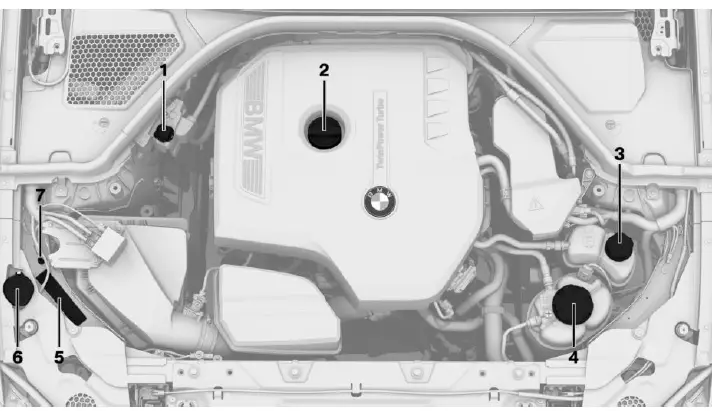
- Jump-starting, positive battery terminal
- Oil filler neck
- Depending on motorization: coolant reservoir for additional radiator
- Coolant reservoir, engine
- Vehicle identification number
- Filler neck for washer fluid
- Jump-starting, negative battery terminal
Hood
Safety information
Warning
Improperly executed work in the engine com-partment can damage vehicle components and impair vehicle functions. There is a risk of an accident and damage to property. Have work in the engine compartment performed by an authorized service center or another qualified service center or repair shop.
Warning
The engine compartment accommodates moving components. Certain components in the engine compartment can also move with the vehicle switched off, for instance the radi-ator fan. There is a risk of injury. Do not reach into the area of moving parts. Keep articles of clothing and hair away from moving parts.
Warning
There are protruding parts, for instance lock-ing hooks, on the inside of the hood. There is a risk of injury. If the hood is open, pay attention to protruding parts and keep clear of these areas.
Warning
An incorrectly locked hood can open while driving and restrict visibility. There is a risk of accident. Stop immediately and correctly close the hood.
Warning
Body parts can be jammed when opening and closing the hood. There is a risk of in-jury. Make sure that the area of movement of hood is clear during opening and closing.
NOTICE
Folded-out wipers can be jammed when the hood is opened. There is a risk of damage to property, among other potential damage. Make sure that the wipers with the wiper blades mounted are folded down onto the windshield before opening the hood.
NOTICE
When the hood is closed, it must engage on both sides. Pressing again can damage the hood. There is a risk of damage to property, among other potential damage. Open the hood again and then close it energetically. Avoid pressing again.
Opening hood
- Pull the lever, arrow 1. Hood is unlocked.
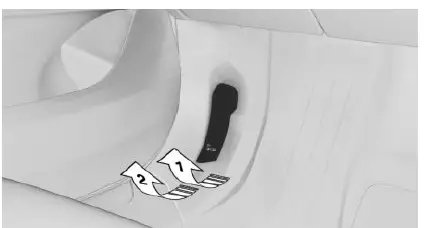
- Release the lever and pull it again, arrow 2. Hood can be opened.
- Be careful of protruding parts on the hood.
Closing the hood
Energetically close the hood from approx. 20 in/50 cm.
The hood must engage on both sides.
Maintenance & Vehicle Care
Operating materials
Vehicle features and options
This chapter describes model-specific equipment, systems and functions that are available now and will be available in the future, even if they are not available in the owned vehicle.
Additional information:
Vehicle equipment
Fuel recommendation
General information
Depending on the region, many filling stations sell fuel that has been customized to winter or summer conditions. Fuel that is available in winter, for instance helps make a cold start easier.
Gasoline
General information
For the best fuel efficiency, the gasoline should be sulfur-free or very low in sulfur content.
Fuels that are marked on the gas pump as containing metal must not be used.
Fuels with a maximum ethanol content of 25 %, i. e. E10 or E25, may be used for refu-eling.
The power and consumption specifications re-fer to operating with RON 98 E10 fuel 
When using minimum quality fuel like RON 91 or fuel with an ethanol content of more than 10% to max. 25%, knocking noises may oc-cur and driving and acoustic performance may change. These have no effect on the engine service life.
Safety information
Caution
The use of poor-quality fuels may result in harmful engine deposits or damage. Additionally, problems relating to drivability, starting and stalling, especially under certain environmental conditions such as high ambient temperature and high altitude, may occur.
If drivability problems are encountered, we recommend switching to a high quality gasoline brand and a higher octane grade — AKI number — for a few tank fills. To avoid harmfulengine deposits, it is highly recommended to purchase gasoline from Top Tier retailers.
Failure to comply with these recommendations may result in the need for additional maintenance.
NOTICE
Even small quantities of the wrong fuel or wrong fuel additives can damage the fuel system and engine. Furthermore, the cat-alytic converter is permanently damaged. There is a risk of damage to property, among other potential damage. Do not refuel or add the following in the case of gasoline engines:
- Leaded gasoline.
- Metallic additives, for instance manganese or iron.
Do not press the Start/Stop button after refueling with the wrong fuel. Contact an authorized service center or another qualified serv-ice center or repair shop.
NOTICE
Fuel that does not comply with the minimum quality can compromise engine function or cause engine damage. There is a risk of damage to property, among other potential damage. Do not fill with fuel that does not comply with the minimum quality.
NOTICE
Incorrect fuels can damage the fuel system and the engine. There is a risk of damage to property, among other potential damage. Do not use fuels with a higher ethanol content than recommended. Do not refuel with fuels containing methanol, e.g. M5 to M100.
Recommended gas quality
BMW recommends AKI 91.
Minimum fuel grade
BMW recommends AKI 87.
If you use gasoline with this minimum AKI Rat-ing, the engine may produce knocking sounds when starting at high external temperatures. This has no effect on the engine life.
Engine oil
General information
The engine oil consumption and engine oil properties depend on the driving style and op-erating conditions.
Therefore, regularly check the engine oil level after refueling by taking a detailed measure-ment.
The engine oil consumption can increase in the following situations, for instance:
- Sporty driving style.
- Break-in of the engine.
- Idle operation of the engine.
- With use of engine oil types that are classified as not suitable.
Different Check Control messages are shown on the control display depending on the engine oil level and engine oil properties.
The vehicle manufacturer recommends that you have an authorized service center or an-other qualified service center or repair shop change the engine oil.
Safety information
NOTICE
An engine oil level that is too low causes engine damage. There is a risk of damage to property, among other potential damage. Immediately add engine oil.
NOTICE
Too much engine oil can damage the engine or the catalytic converter. There is a risk of damage to property, among other potential damage. Do not add too much engine oil. When too much engine oil is added, have the engine oil level corrected by an authorized service center or another qualified service center or repair shop.
NOTICE
Engine oil that is not changed in timely fashion can cause increased engine wear and thus engine damage. There is a risk of dam-age to property. It is recommended that you do not exceed the service intervals indicated in the vehicle.
Electronic oil measurement
General information
The electronic oil measurement has two measuring principles:
- Monitoring.
- Detailed measurement.
When making frequent short-distance trips or using a sporty driving style, for instance when cornering aggressively, regularly perform a de-tailed measurement.
Monitoring
Principle
The engine oil level is monitored electronically while driving and can be shown on the Control Display.
If the engine oil level is outside its permissible operating range, a Check Control message is displayed.
Functional requirements
A current measured value is available after approx. 30 minutes of normal driving.
Displaying the engine oil level
- “MENU”
- “Vehicle apps”
- “Vehicle status”
- “Engine oil level”
The engine oil level is displayed.
System limits
When making frequent short-distance trips or using a sporty driving style, it may not be possible to calculate a measured value. In this case, the measured value for the last, sufficiently long trip is displayed.
Detailed measurement
Principle
The engine oil level is checked when the vehicle is stationary and displayed via a scale.
If the engine oil level is outside its permissible operating range, a Check Control message is displayed.
General information
During the measurement, the idle speed is in-creased somewhat.
Functional requirements
- Vehicle is parked in a horizontal position.
- The drive-ready state is switched on by pressing the Start/Stop button.
- The engine is at operating temperature.
- Selector lever in selector lever position N or P and accelerator pedal not depressed.
Performing a detailed measurement
- “MENU”
- “Vehicle apps”
- “Vehicle status”
- “Engine oil level”
- “Oil level measurement”
- “Start measurement”
The engine oil level is checked and displayed via a scale.
Adding engine oil
General information
Only add engine oil when the message is dis-played in the instrument cluster. The top-up quantity is indicated in the message shown on the Control Display.
Only add suitable types of engine oil.
Safely park the vehicle and switch off drive-ready state before adding engine oil.
Take care not to add too much engine oil.
Safety information
Warning
Operating materials, for instance oils, greases, coolants, fuels, can contain harmful ingredients. There is a risk of injury or danger to life. Follow the instructions on the contain-ers. Avoid the contact of articles of clothing, skin or eyes with operating materials. Do not refill operating materials into different bottles.
Store operating materials out of reach of children.
NOTICE
An engine oil level that is too low causes engine damage. There is a risk of damage to property, among other potential damage. Immediately add engine oil.
NOTICE
Too much engine oil can damage the engine or the catalytic converter. There is a risk of damage to property, among other potential damage. Do not add too much engine oil. When too much engine oil is added, have the engine oil level corrected by an authorized service center or another qualified serv-ice center or repair shop.
Overview
The oil filler neck is located in the engine compartment.
Additional information:
For an overview
Adding engine oil
- Opening the hood.
Opening - Open the lid counterclockwise.

- Add engine oil.
- Close the lid.
2023 BMW 2 Coupe Specs, Price, Features, Mileage (Brochure)
Engine oil types to add
General information
The engine oil grade is critical for the service life of the engine.
Only add with the types of engine oil which are listed.
Safety information
NOTICE
Oil additives can damage the engine. There is a risk of damage to property, among other potential damage. Do not use oil additives.
NOTICE
Incorrect engine oil can cause malfunctions in the engine or damage it. There is a risk of damage to property, among other potential damage. When selecting an engine oil, make sure that the engine oil has the correct oil specification.
Suitable engine oil types
Gasoline engine
- BMW Longlife-12 FE.
- BMW Longlife-17 FE+.
Alternative engine oil types
If an engine oil suitable for continuous use is not available, up to 1 US quart/liter of an engine oil with the following oil rating can be added:
Oil specification
- API SL.
- API SM.
- API SN.
Viscosity grades
- SAE 0W-20.
- SAE 0W-30.
More information about suitable oil specifications and viscosity grades of engine oils can be requested from an authorized service center or another qualified service center or repair shop.
Coolant
General information
Coolant consists of water and coolant additive.
Not all commercially available additives are suitable for the vehicle. The vehicle manufacturer recommends using coolant with the BMW LC-18 specification. Do not mix additives of different colors. Observe the water – additive mixture ratio of 50:50. Information about suit-able additives is available from an authorized service center or another qualified service cen-ter or repair shop.
Safety information
Warning
With the engine hot and the cooling system open, coolant can escape and lead to scald-ing. There is a risk of injury. Only open the cooling system with the engine cooled down.
Warning
Additives are harmful and incorrect additives can damage the engine. There is a risk of injury and risk of damage to property. Do not allow additives to come into contact with skin, eyes or articles of clothing. Use suitable addi-tives only.
Coolant level
General information
The coolant may be overfilled in the coolant reservoir when the vehicle is delivered from the factory. The normal coolant level is achieved by operating the vehicle for a longer period.
The nominal coolant level is indicated by the maximum mark in the filler neck of the coolant reservoir.
Additional information:
For an overview
Checking the coolant level
- Let the engine cool down.
- Opening the hood.
Opening - Turn the lid of the coolant reservoir slightly counterclockwise to allow any excess pres-sure to dissipate, then open it.
- Open the coolant reservoir lid.
- The coolant level is correct when it is just below the maximum mark in the filler neck.

- Close the lid.
Adding coolant
- Let the engine cool down.
- Opening the hood.
Opening - Turn the lid of the coolant reservoir slightly counterclockwise to allow any excess pres-sure to dissipate, then open it.
- Open the coolant reservoir lid.
- If the coolant is low, slowly add coolant up to the specified fill level; do not overfill.
- Close the lid.
- Have the cause of the coolant loss eliminated as soon as possible.
Disposal
 Comply with the relevant environmental protection regulations when disposing of coolant and coolant additives.
Comply with the relevant environmental protection regulations when disposing of coolant and coolant additives.
Washer fluid
General information
All spray nozzles are supplied from one tank.
Use a mixture of tap water and windshield washer concentrate. If desired, a windshield washer concentrate containing antifreeze can be used.
Recommended minimum fill quantity: 0.2 US gal/1 liter.
Safety information
Warning
Some types of antifreeze can contain harmful substances and are flammable. There is a risk of fire and an injury hazard. Follow the instructions on the containers. Keep antifreeze away from ignition sources. Do not refill operating materials into different bottles. Store operating materials out of reach of children.
United States: the washer fluid mixture ratio is regulated by the U.S. EPA and many individual states; do not exceed the allowable washer fluid dilution ratio limits that apply. Follow the usage instructions on the washer fluid container.
Use of BMW’s Windshield Washer Concentrate or the equivalent is recommended.
Warning
Washer fluid can ignite and catch fire on con-tact with hot engine parts. There is a risk of injury or risk of damage to property. Only add washer fluid when the engine is cooled down. Next, fully close the lid of the washer fluid reservoir.
NOTICE
Silicon-containing additives in the washer fluid for the water-repelling effect on the windows can lead to damage to the wash-ing system. There is a risk of damage to property, among other potential damage. Do not add silicon-containing additives to the washer fluid.
NOTICE
Mixing different windshield washer fluid concentrates or antifreeze can damage the washer system. There is a risk of damage to property, among other potential damage. Do not mix different windshield washer fluid concentrates or antifreeze. Follow the information and mixture ratios provided on the containers.
Overview
The washer fluid reservoir is located in the engine compartment.
Malfunction
The use of undiluted windshield washer fluid concentrate or alcohol-based antifreeze can lead to incorrect readings at temperatures be-low +5 ℉/-15 ℃.
Maintenance
Vehicle features and options
This chapter describes model-specific equipment, systems and functions that are available now and will be available in the future, even if they are not available in the owned vehicle.
Additional information:
Vehicle equipmen
BMW maintenance system
The maintenance system provides service notifications and thereby provides support in maintaining road safety and the operational reliability of the vehicle.
In some cases, scopes and intervals of the maintenance system may vary according to the country version. Replacement work, spare parts, fuels and lubricants, and wear materials are calculated separately. Further information is available from an authorized service center or another qualified service center or repair shop.
Condition Based Service
Principle
Condition Based Service determines the maintenance recommendation using sensors and special algorithms that take into account the operating conditions of the vehicle.
The system makes it possible to adapt the amount of maintenance corresponding to your user profile.
General information
Information on service notifications can be dis-played on the control display.
Additional information:
Service notifications
Service data in the vehicle key
Information on the service notifications is continuously stored in the vehicle key. The service center can read this data out and suggest a maintenance scope for the vehicle.
Therefore, hand the service advisor the vehicle key with which the vehicle was driven most recently.
Stationary periods
Stationary periods during which the vehicle battery was disconnected are not taken into account.
If this occurs, have an authorized service center or another qualified service center or repair shop update the time-dependent maintenance procedures, such as checking brake fluid and, if necessary, changing the engine oil and the microfilter/activated charcoal filter.
Maintenance Booklet for US Models
Please consult your Maintenance Booklet for additional information on the performance of service and maintenance work.
The manufacturer of your vehicle recommends that maintenance and repair be performed by a service center or another qualified service center or repair shop. Records of regular maintenance and repair work should be retained.
Diagnostic socket
General information
Devices connected to the diagnostic socket will trigger the alarm system after locking the vehicle.
Remove devices connected to the diagnostic socket before locking the vehicle.
Safety information
NOTICE
The socket for Onboard Diagnosis is an intricate component intended to be used in conjunction with specialized equipment to check the vehicle’s primary emissions sys-tem. Improper use of the socket for Onboard Diagnosis, or contact with the socket for On-board Diagnosis for other than its intended purpose, can cause vehicle malfunctions and creates risks of personal and property dam-age. Given the foregoing, the manufacture of your vehicle strongly recommends that ac-cess to the socket for Onboard Diagnosis be limited to an authorized service center or an-other qualified service center or repair shop or other persons that have the specialized training and equipment for purposes of prop-erly utilizing the socket for Onboard Diagno-sis.
Position 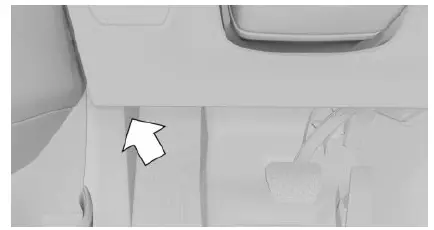
There is a diagnostic socket on the driver’s side for reading out vehicle data.
Emissions
 The warning light lights up: Emissions are deteriorating. Have the vehicle checked as soon as possible.
The warning light lights up: Emissions are deteriorating. Have the vehicle checked as soon as possible.- The warning light flashes under certain circumstances:
This indicates that there is excessive misfiring in the engine.
Reduce the vehicle speed and have the system checked immediately; otherwise, serious engine misfiring within a brief period can seriously damage emission control components, in particular the catalytic converter.
Replacing components
Vehicle features and options
This chapter describes model-specific equip-ment, systems and functions that are available now and will be available in the future, even if they are not available in the owned vehicle.
Additional information:
Vehicle equipment
Onboard vehicle tool kit
The onboard toolkit is located to the left of the trunk in the open compartment.
Wiper blades
Safety information
NOTICE
The window may sustain damage if the wiper falls onto it without the wiper blade installed. There is a risk of damage to property, among other potential damage. Hold the wiper firmly when changing the wiper blade. Do not fold in or switch on the wiper without a wiper blade installed.
NOTICE
Folded-out wipers can be jammed when the hood is opened. There is a risk of damage to property, among other potential damage. Make sure that the wipers with the wiper blades mounted are folded down onto the windshield before opening the hood.
Replacing the wiper blades
- To change the wiper blades, bring wipers into fold-out position.
Fold-out position of the wipers - Fold out and hold the wiper arm firmly.
- Squeeze the retaining spring, arrow 1, and fold up the wiper blade, arrow 2.
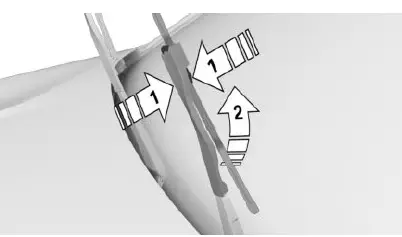
- Remove the wiper blade forward from the detent.
- Insert the new wiper blade in reverse order of removal until it locks in place.
- Fold in the wipers.
Lights and bulbs
General information
Lights and bulbs make an essential contribution to driving safety.
All headlights and lights are designed using LED technology at least.
Some items of equipment use light-emitting diodes installed behind a cover as a light source. These light-emitting diodes are designated Class 1 light-emitting diodes.
The manufacturer of the vehicle recommends that you let an authorized service center or another qualified service center or repair shop perform the work in case of a malfunction.
Safety information
Warning
Intense brightness can irritate or damage the retina of the eye. There is a risk of injury. Do not look directly into the headlights or other light sources. Do not remove the LED covers.
Headlight glass
The inside of the headlight glass can fog up in cool or humid weather. When driving with the lights switched on, the condensation evap-orates after a short time. The headlight glass does not need to be changed.
If, despite driving with the headlights switched on, moisture such as water droplets increas-ingly forms in the light, have the headlights checked.
Vehicle battery
General information
The battery is maintenance-free.
More information about the battery can be re-quested from an authorized service center or another qualified service center or repair shop.
Safety information
DANGER
Contact with live components can lead to an electric shock. There is a risk of injury or dan-ger to life. Do not touch any components that are under voltage.
Warning
Vehicle batteries that are not compatible can damage vehicle systems and impair vehicle functions. There is a risk of an accident and damage to property. Only vehicle batteries that are compatible with your vehicle type should be installed in your vehicle. Informa-tion on compatible vehicle batteries is availa-ble at an authorized service center.
Registering the battery to the vehicle
The manufacturer of the vehicle recommends that you have an authorized service center or another qualified service center or repair shop register the vehicle battery to the vehicle after the battery has been changed. Once the bat-tery has been registered again, all comfort fea-tures will be available without limitation and any Check Control messages displayed which relate to comfort features will disappear.
Charging the battery
General information
Make sure that the battery is always sufficiently charged to guarantee that the battery remains usable for its full service life.
Safety information
NOTICE
Battery chargers that charge the vehicle bat-tery via sockets or cigarette lighters in the vehicle may overload or damage the 12 V electrical system. There is a risk of damage to property, among other potential damage. Only connect battery chargers for the vehicle battery to the jump-start terminals in the engine compartment.
Charging the battery
Charge the battery only when the engine is off and via the jump-start terminals in the engine compartment.
With Mild Hybrid technology: charge the bat-tery only when the hood is opened.
Additional information:
Jump-start terminals
Power interruption
After a power interruption, some equipment needs to be newly initialized or individual set-tings updated, for example:
- Parking brake
- With Memory function: store the positions again.
- Time: update.
- Date: update.
Mild Hybrid technology
Principle
Part of the Mild Hybrid technology is a battery that works with a voltage of 48 volts. Mild Hybrid technology can lower the fuel consumption.
Safety information
DANGER
Contact with live components can lead to an electric shock. There is a risk of injury or dan-ger to life. Do not touch any components that are under voltage.
Overview
The battery for the Mild-Hybrid technology is located under a cover in the engine compart-ment on the front passenger side.
Removing the cover
- Turn lid up to the opened lock symbol
 arrow 1.
arrow 1. 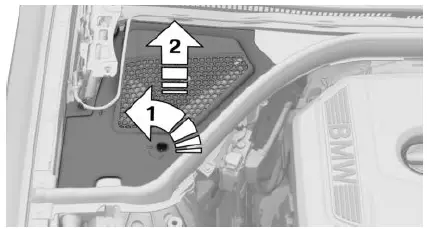
- Remove cover, arrow 2.
Notice
Do not exchange or work on the battery for the Mild Hybrid technology.
Disposing of old batteries
Have old batteries disposed of by an authorized service center or another qualified service center or repair shop or take them to a collection point.
Maintain the filled battery in an upright position for transport and storage. Secure the battery so that it does not tip over during transport.
Fuses
General information
The fuses are located at different places in the vehicle.
Information on the fuse layout and the positions of the fuse boxes is available on the In-ternet: fusecard.bmw.com.
Safety information
Warning
Incorrect and repaired fuses can overload electrical lines and components. There is a risk of fire. Never attempt to repair a blown fuse. Do not replace a nonworking fuse with a substitute of another color or amperage rat-ing.
Replacing fuses
The vehicle manufacturer recommends that you have an authorized service center or an-other qualified service center or repair shop re-place the fuses.
Breakdown Assistance
Vehicle features and options
This chapter describes model-specific equip-ment, systems and functions that are available now and will be available in the future, even if they are not available in the owned vehicle.
Additional information:
Vehicle equipment
Hazard warning system 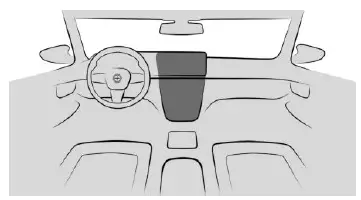
 Hazard warning system button
Hazard warning system button
The red light in the button blinks when the hazard warning system is turned on.
Warning triangle
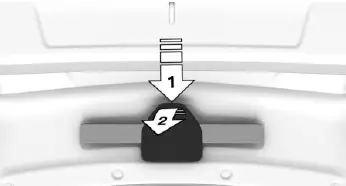
The warning triangle is located on the inside of the tailgate. Press on the release, arrow 1, and swivel the cover down, arrow 2.
First-aid kit
General information
Depending on the vehicle equipment and na-tional-market version, the vehicle is equipped with a first-aid kit.
Some of the articles have a limited service life.
Check the expiration dates of the contents reg-ularly and replace any expired items promptly.
Storage
Storage for the first-aid kit is provided in the right side of the cargo area.
BMW Roadside Assistance
Principle
BMW Group Roadside Assistance can be con-tacted if assistance is needed in the event of a breakdown.
General information
In the event of a breakdown, data on the ve-hicle’s condition is transmitted to the BMW Roadside Assistance.
There are various ways of contacting BMW Roadside Assistance.
- Via a Check Control message. Supplementary text messages
- Via a call with a mobile phone.
- Via the BMW app.
Functional requirements
- Active Connected Drive contract, equipment with intelligent emergency call or BMW Connected Drive services.
- Cellular network reception.
- Standby state is switched on.
Starting BMW Roadside Assistance manually
If the vehicle is equipped with Teleservices, support is first offered through Teleservice Di-agnosis and, where applicable, then through Teleservice Help.
- “MENU”
- “All apps”
- “BMW Assistance”
- Select the desired service.
A voice connection to the selected service is established.
Teleservice Diagnosis
Teleservice Diagnostics enables detailed vehi-cle data to be transmitted via cellular networks, which is necessary for vehicle diagnosis. This data is transmitted automatically. It may be necessary to approve this on the control dis-play.
Teleservice Help
Depending on the country, Teleservice Help enables an in-depth diagnosis of the vehicle by BMW Roadside Assistance via wireless trans-mission.
You can launch Teleservice Help by requesting it through BMW Roadside Assistance.
- Park the vehicle in a safe place.
- Set the parking brake.
- Turn on control display.
- Consent to Teleservice Help.
BMW Accident Assistance
Principle
BMW Group Accident Assistance can be con-tacted if assistance is needed in the event of an accident.
General information
If the vehicle sensors detect a minor to moder-ately severe accident, which did not deploy any airbags, a Check Control message is displayed in the instrument cluster. In addition, a text message appears on the Control Display.
When BMW Accident Assistance is triggered, data on the vehicle’s condition is sent to BMW.
Functional requirements
- Active Connected Drive contract, equipment with intelligent emergency call or BMW ConnectedDrive services.
- Cellular network reception.
- Standby state is switched on.
Starting BMW Accident Assistance
If an accident is detected automatically
A text message relating to BMW Accident As-sistance appears on the control display.
The connection can be established directly:
“Contact accident assistance”
The Check Control message for BMW Accident Assistance can also be called up from the stored Check Control messages for a certain length of time.
Additional information:
Check Control
Starting BMW Accident Assistance manually
BMW Accident Assistance can also be con-tacted independently of the automatic accident detection function.
- MENU”
- All apps”
- BMW Assistance”
- If necessary, select the entry for BMW Acci-dent Assistance.
Follow the displays on the control display. A voice connection is established.
Emergency Call
Intelligent emergency call
Principle
In case of an emergency, an emergency call can be triggered automatically by the system or manually.
General information
Depending on the vehicle equipment and na-tional-market version, the vehicle is equipped with an Assist system.
Only press the SOS button in an emergency.
The Intelligent Assist system establishes a connection with the BMW Response Center.
For technical reasons, the emergency call can-not be guaranteed under unfavorable conditions.
Overview
 SOS button
SOS button
Functional requirements
- Standby state is switched on.
- The Assist system is functional.
- If the vehicle is equipped with intelligent emergency call: the integrated SIM card in the vehicle has been activated.
Automatic triggering
Under certain conditions, for example if the airbags are deployed, an emergency call is au-tomatically triggered immediately after an acci-dent of corresponding severity. Automatic Col-lision Notification is not affected by pressing the SOS button.
Manual triggering
- Tap the cover flap.
- Press and hold the SOS button until the LED in the area of the button illuminates green.
- The LED is illuminated green when an emergency call has been initiated.
If a cancel prompt appears on the control display, the emergency call can be aborted. - If the situation allows, wait in your vehicle until the voice connection has been estab-lished.
- The LED flashes green when a connection to the BMW Response Center has been es-tablished.
The BMW Response Center then makes contact with the occupants of the vehicle and initiates further steps to help.
Even if you are unable to respond, the BMW Response Center can take further steps to help you under certain circumstan-ces.
For this purpose, data that serves to deter-mine the necessary rescue measures, for instance the current position of the vehicle when it can be determined, is transmitted to the BMW Response Center.
Even if the BMW Response Center is no longer heard through the loudspeakers, the BMW Response Center may still be able to hear the occupants of the vehicle.
The BMW Response Center ends the emergency call.
- The LED is illuminated green when an emergency call has been initiated.
2023 BMW 2 Coupe Specs, Price, Features, Mileage (Brochure)
Malfunction
The function of the emergency call may be impaired.
The LED near the SOS button flashes for approximately 30 seconds. A Check Control mes-sage is displayed.
Have it checked by an authorized service center or another qualified service center or repair shop.
Jump-starting
General information
If the battery is discharged, the engine can be started using the battery of another vehicle and two jumper cables. Only use jumper cables with fully insulated clamp handles.
Safety information
DANGER
Contact with live components can lead to an electric shock. There is a risk of injury or dan-ger to life. Do not touch any components that are under voltage.
Warning
If the jumper cables are connected in the incorrect order, spark formation may occur. There is a risk of injury. Pay attention to the correct order during connection.
NOTICE
In the case of body contact between the two vehicles, a short circuit can occur dur-ing jump-starting. There is a risk of damage to property, among other potential damage. Make sure that no body contact occurs.
Preparation
- Check whether the battery of the other vehicle has a voltage of 12 volts. The voltage information can be found on the battery.
- Switch off the engine of the assisting vehicle.
- Switch off any electrical components in both vehicles.
Jump-start terminals
The jump-start terminals are located in the en-gine compartment.
Additional information:
For an overview
Open the covers of the jump-start terminals.
Connecting the cables
Before you begin, switch off all unnecessary electronic systems/components, such as the radio, on the assisting and receiving vehicles.
- Open the lid of the jump-start terminal.
- Attach one terminal clamp of the positive jumper cable to the positive battery termi-nal, or to the corresponding jump-start ter-minal of the vehicle providing assistance.
- Attach the terminal clamp on the other end of the cable to the positive battery terminal, or to the corresponding jump-start terminal of the vehicle to be started.
- Attach one terminal clamp of the negative jumper cable to the negative battery termi-nal, or to the corresponding engine or body ground of assisting vehicle.
- Attach the second terminal clamp to the negative battery terminal, or to the corre-sponding engine or body ground of the ve-hicle to be started.
Starting the engine
Never use spray fluids to start the engine.
- Start the engine of the assisting vehicle and let it run for several minutes at an increased idle speed.
If the vehicle to be started has a diesel en-gine: let the engine of the assisting vehicle run for approx. 10 minutes. - Start the engine of the vehicle that is to be started in the usual way.
If the first attempt to start the engine is not successful, wait a few minutes before mak-ing another attempt in order to allow the discharged battery to recharge. - Let both engines run for several minutes.
- Disconnect the jumper cables in the reverse order.
Check the battery and recharge, if needed.
Tow-starting and towing
Safety information
Warning
Individual functions may not work correctly when towing with Front Collision Warning en-abled or Cruise Control switched on. There is a risk of accident. Switch off Front Collision Warning and Cruise Control before towing.
Steptronic transmission: Transporting the vehicle
General information
Do not transport the vehicle by towing it.
Safety information
NOTICE
The vehicle can be damaged when towing the vehicle with a single lifted axle. There is a risk of damage to property, among other potential damage. The vehicle should only be transported on a loading platform.
NOTICE
The vehicle can become damaged when lift-ing and securing it.
There is a risk of damage to property, among other potential damage.
- Lift the vehicle using suitable means.
- Do not lift or secure the vehicle by its tow fitting, body parts, or suspension parts.
Pushing the vehicle
To remove a broken-down vehicle from the hazardous area, push it for a short distance at a speed of no more than 6 mph/10 km/h.
Additional information:
Rolling or pushing the vehicle
Tow truck 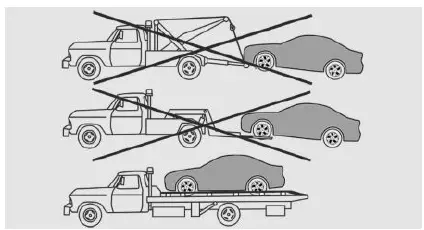
The vehicle should only be transported on a loading platform.
Towing other vehicles
General information
Switch on the hazard warning system, de-pending on local regulations.
If the electrical system has failed, clearly iden-tify the vehicle being towed by placing a sign or a warning triangle in the rear window.
Safety information
Warning
If the approved gross vehicle weight of the towing vehicle is lighter than the vehicle to be towed, the tow fitting can tear off or it will not be possible to control handling. There is a risk of accident. Make sure that the gross vehicle weight of the towing vehicle is heavier than the vehicle to be towed.
Warning
Different levels of braking may occur when towing with adaptive recuperation. There is a risk of accident. Deactivate adaptive recuper-ation before towing.
NOTICE
If the tow bar or tow rope is attached incorrectly, damage to other vehicle parts can oc-cur. There is a risk of damage to property, among other potential damage. Correctly at-tach the tow bar or tow rope to the tow fitting.
Tow bar
The tow fittings used should be on the same side on both vehicles.
If it is impossible to avoid mounting the tow bar at an inclination, note the following:
- Free movement is limited when cornering.
- The tow bar will generate lateral forces if it is secured with an inclination.
Tow rope
Observe the following notes when using the tow rope:
- Use nylon ropes or straps, which will enable the vehicle to be towed without jerking.
- Make sure the tow rope is not twisted when fastening.
- Check the attachment of the tow fitting and tow rope in regular intervals.
- Do not exceed a towing speed of 30 mph/50 km/h.
- Do not exceed a towing distance of 3 miles/5 km.
- When driving off to tow the vehicle, make sure that the tow rope is taut.
Tow fitting
General information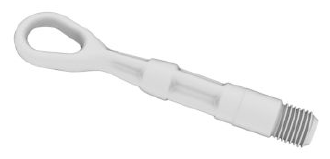
The screw-in tow fitting should always be carried in the vehicle.
The tow fitting can be screwed in at the front or rear of the vehicle.
The tow fitting is found in the onboard vehicle tool kit.
Observe the following notes when using the tow fitting:
- Use only the tow fitting provided with the vehicle.
- Turn the tow fitting at least 5 turns clockwise and screw it in as far as it will go. If necessary, tighten with a suitable object.
- After use, unscrew the tow fitting counter-clockwise.
- Use the tow fitting for towing on paved roads only.
- Avoid lateral loading of the tow fitting, for instance do not lift the vehicle by the tow fitting.
- Check the attachment of the tow fitting in regular intervals.
Additional information:
Onboard vehicle tool kit
Safety information
NOTICE
If the tow fitting is not used as intended, there may be damage to the vehicle or to the tow fitting. There is a risk of damage to property, among other potential damage. Follow the notes on using the tow fitting.
Screw thread for tow fitting
Press on the mark on the edge of the cover to push it out.
Tow-starting
Do not tow-start the vehicle.
Start the engine by jump-starting, if possible.
Have the cause of the starting difficulties corrected by an authorized service center or another qualified service center or repair shop.
Additional information:
Jump-starting
Vehicle Care
Vehicle features and options
This chapter describes model-specific equipment, systems and functions that are available now and will be available in the future, even if they are not available in the owned vehicle.
Additional information:
Vehicle Equipment
Washing the vehicle
General information
Regularly remove foreign bodies such as leaves or snow in the area below the wind shield.
Wash your vehicle frequently, particularly in winter. Intense contamination and road salt can damage the vehicle.
Additional information:
Fold-out position of the wipers
Safety information
NOTICE
When washing with an open fuel filler flap, damage may occur. There is a risk of dam-age to property, among other potential dam-age. Close the fuel filler flap before washing. Clean dirt behind the fuel filler flap with a cloth.
Steam cleaner and high-pressure cleaner
Safety information
NOTICE
When cleaning with high pressure cleaners, components can be damaged due to the pressure or temperatures being too high. There is a risk of damage to property, among other potential damage. Maintain sufficient distance and do not spray too long continuously. Follow the operating instructions for the high pressure cleaners.
Distances and temperature
- Maximum temperature: 140 ℉/60 ℃.
- Minimum distance from sensors, cameras, seals and lights: 12 inches/30 cm.
- Minimum distance from glass sunroof: 31.5 in/80 cm.
Automatic car washes or car washes
Safety information
NOTICE
Using a car wash with high pressure washers may result in water penetration of window areas. There is a risk of damage to property, among other potential damage. Do not drive into high-pressure car wash systems.
NOTICE
Improper use of automatic car washes can cause damage to the vehicle. There is a risk of damage to property, among other po-tential damage. Follow the following instruc-tions:
- Give preference to cloth car washes or those that use soft brushes in order to avoid paint damage.
- Do not drive through a car wash with guide rails higher than 4 in/10 cm to avoid damage to the body.
- Observe the tire width of the guide rail to avoid damage to tires and rims.
- Fold in exterior mirrors to avoid damage to the exterior mirrors.
- Deactivate the wiper and, if necessary, rain sensor to avoid damage to the win-dow wiper system.
2023 BMW 2 Coupe Specs, Price, Features, Mileage (Brochure)
Driving into a car wash
NOTICE
Selector lever position P is automatically en-gaged when standby state is switched off. The wheels are blocked. There is a risk
of damage to property. Do not switch off standby if the vehicle is meant to coast, e.g., in a car wash.
In a car wash, the vehicle must be able to roll freely.
Some car washes do not permit persons in the vehicle. The vehicle cannot be locked from the outside when in selector lever position N. A signal sounds when an attempt is made to lock the vehicle.
Additional information:
Rolling or pushing the vehicle
Driving out of a car wash
Ensure that the vehicle key is in the car.
Turn on drive-ready state.
Additional information:
Drive-ready state
Lights
Do not rub wet lights dry and do not use abrasive or acidic cleaning agents or cleaning agents containing alcohol.
Soak areas that have been dirtied, for instance from insects, with auto shampoo and wash off with water.
Thaw ice with de-icing spray; do not use an ice scraper.
After washing the vehicle
After washing the vehicle, apply the brakes briefly to dry them; otherwise, braking effect can be reduced. The heat generated during braking dries brake disks and brake pads and protects them against corrosion.
Completely remove all residues on the win-dows to minimize loss of visibility due to smearing and to reduce wiper noises and wiper blade wear.
Vehicle care
Vehicle care products
General information
BMW recommends using vehicle care and cleaning agents from BMW. Suitable vehicle care products are available from an authorized service center or another qualified service cen-ter or repair shop.
Vehicle paintwork
General information
Regular vehicle care contributes to driving safety and value retention. Environmental in-fluences in areas with elevated air pollution or natural contaminants, such as tree resin or pollen, can affect the vehicle paintwork. Tailor the frequency and extent of your vehicle care to these influences.
Aggressive substances such as spilled fuel, oil, grease or bird droppings, must be removed immediately to prevent alterations or discolor-ations of the finish.
Matte paintwork
Only use cleaning and care products suitable for vehicles with matte paintwork.
Leather care
Remove dust from the leather regularly, using a cloth or vacuum cleaner.
Otherwise, particles of dust and road grime chafe in pores and folds, and lead to heavy abrasion and premature degradation of the leather surface.
To guard against discoloration, such as from clothing, clean leather and provide leather care roughly every two months.
Clean light-colored leather more frequently be-cause contamination on such surfaces is sub-stantially more visible. Use leather care products; otherwise, dirt and grease will gradually break down the protective coating of the leather surface.
Remove aggressive substances, e.g., sunscreen, immediately to prevent alterations or discolorations of the leather.
Synthetic leather care
Clean synthetic leather regularly with a damp microfiber cloth or vacuum cleaner.
Otherwise, dust and road grime particles will rub into pores and folds, causing significant abrasion and premature degradation of the surface.
In case of major soiling, use a moist soft sponge or microfiber cloth with suitable interior cleaners.
Immediately remove aggressive substances, e.g., sunscreen, to prevent alterations or dis-colorations of the synthetic leather.
Fabric care
General information
In case of major contaminations, such as bev-erage stains, use a moist soft sponge or micro-fiber cloth with a suitable interior cleaners.
Immediately remove aggressive substances, e.g., sunscreen, to prevent alterations or dis-colorations of the fabric.
Safety information
NOTICE
Open hook and loop fasteners on articles of clothing can damage the seat covers and other cloth upholstery in the vehicle. There is a risk of damage to property, among other potential damage. Ensure that any Velcro® fasteners are closed.
Upholstery material care
Vacuum regularly with a vacuum cleaner. Clean extensively down to the seams. Avoid rubbing the material vigorously.
Textile care
Use a microfiber cloth for cleaning minor con-tamination.
Dampen the cloth with water.
Caring for special components
Displays, operating elements, and protective glass of the Head-up display
NOTICE
Surfaces can be damaged by improper cleaning, e.g., by using chemical cleaners, or from moisture or liquid of any kind. Physical damage to the material is possible.
- Avoid pressure that is too high and do not use any scratching materials.
- Use a dry, clean antistatic microfiber cloth for cleaning displays.
- Clean the operating elements and, de-pending on vehicle equipment, the pro-tective glass of the Head-up display with a damp microfiber cloth and standard household dish soap.
Light-alloy wheels
When cleaning the vehicle, use only neutral rim cleaners having a pH value from 5 to 9. Do not use abrasive cleaning agents or steam clean-ers above 140 ℉/60 ℃. Follow the manufacturer’s instructions.
Aggressive, acidic or alkaline cleaning agents can destroy the protective coating of adjacent components, such as the brake disk.
After cleaning, apply the brakes shortly to dry them. The heat generated during braking dries brake disks and brake pads and protects them against corrosion.
Chrome surfaces
Carefully clean Chrome surfaces, especially in case of exposure to road salt, with plenty of water and added auto shampoo as needed.
Rubber components
Environmental influences can cause surface contamination of rubber parts and a loss of gloss. Use only water and suitable cleaning agents for cleaning.
Treat especially worn rubber parts with rubber care products at regular intervals. When clean-ing rubber seals, do not use any silicon-con-taining vehicle care products in order to avoid damage or noises.
Wiper blades
The wiper blades are cleaned by using the washer system.
Avoid cleaning the wiper blades manually, as this may reduce wiper performance.
Fine wood parts
Clean the fine wood veneer and fine wood components solely with a moist rag. Then dry with a soft cloth.
Kenaf
Only treat parts made of Kenaf fibers using a suitable care product.
Plastic components
NOTICE
Solvent cleaners that contain alcohol or sol-vents, such as lacquer thinners, cold cleaning agents, fuel and such, can damage plastic parts. There is a risk of damage to property, among other potential damage. Clean with a microfiber cloth. Dampen the cloth lightly with water, if needed. Clean with a microfiber cloth.
Dampen the cloth lightly with water, if needed. Do not soak the headliner.
Seat belts
Warning
Chemical solvent cleaners can destroy the seat belt fabric. Missing protective effect of the seat belts. There is a risk of injury or dan-ger to life. Use only a mild soap solution for cleaning the seat belts.
Dirty belt straps impede the reeling action and thus have a negative impact on safety.
Use only a mild soap solution for cleaning the installed belt straps.
Seat belts should only be allowed to retract if they are dry.
Carpets and floor mats
Warning
Objects in the driver’s footwell can limit the pedal travel or block a depressed pedal. There is a risk of accident. Stow objects in the vehicle such that they are secured and can-not enter into the driver’s footwell. Use floor mats that are suitable for the vehicle and can be safely attached to the floor. Do not use loose floor mats and do not layer several floor mats. Make sure that there is sufficient clearance for the pedals. Ensure that the floor mats are securely fastened again after they were removed, for instance for cleaning.
The floor mats can be removed from the interior for cleaning.
If the floor carpets are very contaminated, clean with a microfiber cloth and water or a textile cleaner. To prevent matting of the car-pet, rub back and forth in the driving direction only.
Trailer hitch with removable ball head
Keep ball and receptacle clean.
Regularly grease or oil bearings, sliding surfaces and the small balls on the holding pin with resin-free greases or oils.
Before using steam cleaners or high-pressure cleaners on the vehicle, remove the ball head and attach the cover to the receptacle.
Do not clean ball head with steam cleaner or high-pressure cleaner.
Sensors and camera lenses
To clean sensors and camera lenses, use a cloth moistened with a small amount of glass detergent.
Taking the vehicle out of service
When the vehicle is shut down for longer than three months, special measures must be taken. Further information is available from an authorized service center or another qualified service center or repair shop.
Q&A
- What is the location of the engine compartment in the BMW 2 Series Coupe 2023?
- The engine compartment of the BMW 2 Series Coupe 2023 is located in the front of the vehicle and is easily accessible for routine maintenance.
- What type of engine does the BMW 2 Series Coupe 2023 have?
- The BMW 2 Series Coupe 2023 has a 2.0-liter BMW TwinPower Turbo inline 4-cylinder engine.
- What is the horsepower and torque output of the engine of the BMW 2 Series Coupe 2023?
- The engine of the BMW 2 Series Coupe 2023 delivers up to 255 horsepower and 295 lb-ft of torque.
- What type of transmission does the BMW 2 Series Coupe 2023 have?
- The BMW 2 Series Coupe 2023 has an 8-speed Sport Automatic transmission.
- What maintenance schedule should be followed for the BMW 2 Series Coupe 2023?
- The recommended maintenance schedule for the BMW 2 Series Coupe 2023 is outlined in the owner’s manual.
- What are the recommended maintenance procedures for the engine of the BMW 2 Series Coupe 2023?
- The recommended maintenance procedures for the engine of the BMW 2 Series Coupe 2023 include regular oil changes, air filter replacement, and spark plug replacement.
- What other components of the BMW 2 Series Coupe 2023 require regular maintenance?
- Other components of the BMW 2 Series Coupe 2023 that require regular maintenance include the brakes, suspension, and tires.
- How often should the brake pads and rotors of the BMW 2 Series Coupe 2023 be inspected?
- The brake pads and rotors of the BMW 2 Series Coupe 2023 should be inspected regularly as part of the maintenance schedule.
- What is the importance of inspecting the belts and hoses of the BMW 2 Series Coupe 2023?
- Regular inspection of the belts and hoses of the BMW 2 Series Coupe 2023 is important to ensure they are in good condition and working properly.
- Why is it important to have the wheels of the BMW 2 Series Coupe 2023 aligned and balanced periodically?
- Having the wheels of the BMW 2 Series Coupe 2023 aligned and balanced periodically is important to ensure proper handling and performance.
- Who should inspect and maintain the BMW 2 Series Coupe 2023?
- The BMW 2 Series Coupe 2023 should be inspected and maintained by a certified BMW technician.
- How can regular maintenance of the BMW 2 Series Coupe 2023 affect its performance and reliability?
- Regular maintenance of the BMW 2 Series Coupe 2023 can help ensure optimal performance and reliability, as well as prolong its lifespan.
- What is the recommended maintenance schedule for the suspension of the BMW 2 Series Coupe 2023?
- The recommended maintenance schedule for the suspension of the BMW 2 Series Coupe 2023 is outlined in the owner’s manual.
- How can tire pressure and tread depth affect the performance of the BMW 2 Series Coupe 2023?
- Proper tire pressure and tread depth are important for optimal handling and performance of the BMW 2 Series Coupe 2023.
- Can regular maintenance of the BMW 2 Series Coupe 2023 help prevent costly repairs?
- Yes, regular maintenance of the BMW 2 Series Coupe 2023 can help prevent costly repairs by identifying potential issues before they become major problems.
2023 BMW 2 Coupe Specs, Price, Features, Mileage (Brochure)
Useful Link
BMW 2 SERIES COUPE 2023 User Manual
https://www.bmwusa.com/owners-manuals.html

